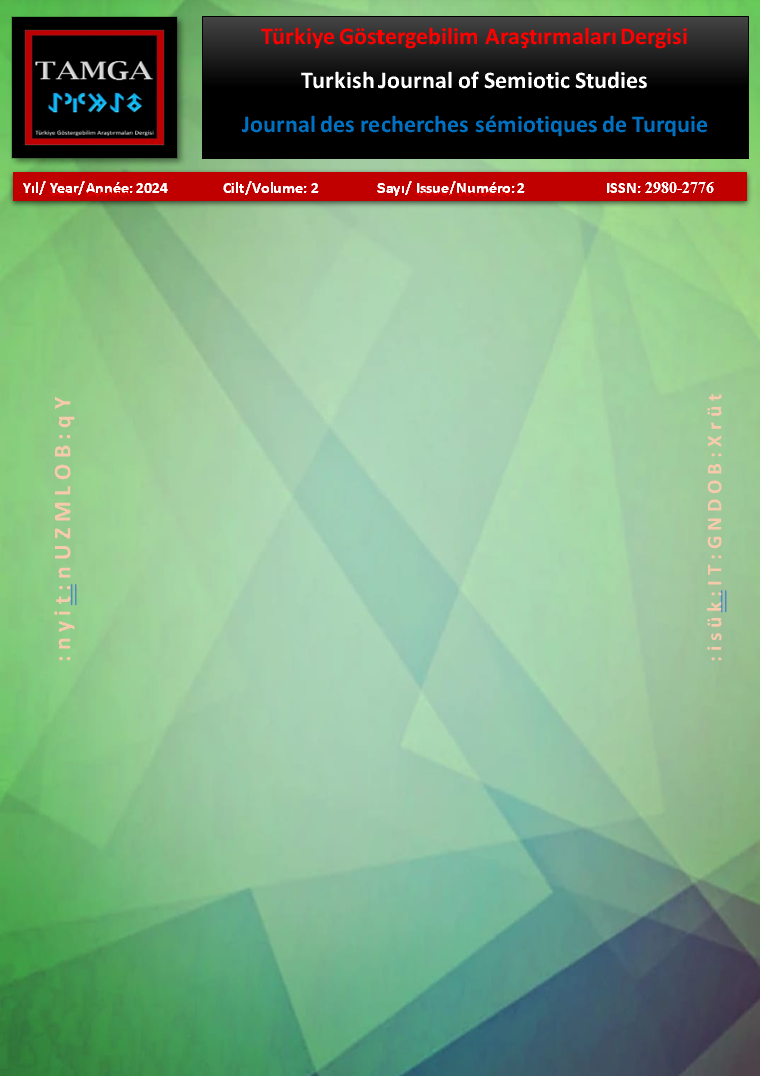Understanding and interpreting the symbolic meaning of Cehennemağzı Caves
DOI:
https://doi.org/10.5281/zenodo.14568612Keywords:
Semiotics, Cehennemağzı Caves, Charles S. Peirce, understanding and interpretationAbstract
This study aims to examine how the rich visual meanings and aesthetic values with historical dimensions of the Cehennemağzı Caves convey messages to viewers; to create cultural awareness in the transfer of natural and cultural resources to future generations, aiming to reach historical, aesthetic, and symbolic richness and introduce these values to a wide audience. The research on the Cehennemağzı Caves aims to determine the historical, cultural, aesthetic, and communicative aspects of the motifs and symbols in the caves. At the same time, the purpose of this research is to create awareness by drawing attention to symbolic and figurative motifs that best reflect universal and national values. The stages of the study are approached as sign analysis steps defined by Charles S. Peirce. These stages are defined as the analysis of the sign itself, the analysis of the relationship between the sign and the object, and the analysis of the relationship between the sign and the interpreter. The limitations of the study cover the figures and archaeological elements (symbols) from that period found in the Cehennemağzı Caves. Field research and document analysis are used together. While the photographs taken in the caves are obtained as a result of field research, data on the discovery, formation, and recording of symbols are handled through the document analysis method. Direct observation, participant observation, qualitative interviews, ethnography, and case analyses were used in the field research, and the direct observation method was used. The fact that the symbolic analysis of the Cehennemağzı Caves has not been previously conducted constitutes the significance of our study. The aesthetic and symbolic value analysis we conducted through the Cehennemağzı Caves draws attention to the complexity of symbols and signs and the relational nature of meaning, in harmony with Charles S. Peirce's theory of semiotics. This analysis will help us understand the aesthetic and symbolic values of the caves and transfer the cultural heritage to future generations accurately. It has been demonstrated in this study that access to historical, aesthetic, and symbolic values can be achieved through research based on cultural consciousness in the light of Charles S. Peirce's theory, and these values can be introduced in a specific and general sense.
References
Akerson, F. E. (1987). Göstergebilime Giriş (1. Baskı). Alan Yayıncılık
Akerson, F. E. (2005). Göstergebilime giriş. Multilingual Yayınları.
Bhattacharjee, A. (2012). Social Science Research: Principles, Methods and Practices. USF Tampa Bay Open Access Textbooks Collection, Book 3. http://scholarcommons.usf.edu/oa_textbooks/3/
Bowen, A. G. (2009). Document analysis as a qualitative research method. Qualitative Research Journal, 9(2), 27-40.
Clarke, D. S. (1990). Sources of Semiotic. Southern Illinois University.
Corbin, J., & Strauss, A. (2008). Basics of qualitative research: Techniques and procedures for developing grounded theory (3. Baskı). Sage.
Dörner, F. K. (1972). Herakleia Pontike Tarih ve Topografik Araştırmalar. Avusturya Bilimler Akademisi Komisyon Yayınevi.
Hodder, I. (2003). The interpretation of documents and material culture. İçinde N.K. Denzin & Y. S. Lincoln (Ed.), Collecting and interpreting qualitative materials (2. Baskı). Sage. (ss.155-175).
Karakuzulu, Z. (2002). Cehennemağzı (Kdz. Ereğli) Mağaraları’nın Turizm Coğrafyası Açısından Önemi. Sosyal Bilimler Dergisi, 2(28-29), 227-243.
Kıran, A. E., & Kıran, Z. (2006). Dilbilime giriş –dilbilgisinden dilbilime. Seçkin Yayıncılık.
Özmakas, U. (2009). Charles Sanders Peirce’in gösterge kavramı. Uşak Üniversitesi Sosyal Bilimler Dergisi, 2(1), 32-45.
Peirce, C. (1982). Writings of Charles S. Peirce (U. Özmakas, Çev.). A Chronological Edition, 1, (1857-1866), 323-339.
Peirce, C. (1984). Writings of Charles S. Peirce (U. Özmakas, Çev.). A Chronological Edition, 5, (1984-1886), 227-229.
Rifat, M. (2000). XX. yüzyılda dilbilim ve göstergebilim kuramları. Om Yayınevi.
Rifat, M. (2005). XX. yüzyılda dilbilim ve göstergebilimin kuramları. Yapı Kredi Yayınları.
Rifat, M. (2014). Göstergebilimin abc’si. Say Yayınları.
Stake, R. E. (1995). The art of case study research. Thousand Oaks. Sage
Toklu, O. (2003). Dilbilime giriş. Akçağ Yayınları.
Uzuner, Y. (1999). Niteliksel araştırma yaklaşımı. İçinde Uzuner, Y. (Ed.), Niteliksel araştırma yaklaşımı: Sosyal bilimlerde araştırma yöntemleri. T. C. Anadolu Üniversitesi Yayınları. (ss. 175-190).
Yaylagül, Ö. (2015). Göstergebilim ve dilbilim. Hece Yayınları.
Yıldırım, A., & Şimşek, H. (2011). Sosyal bilimlerde nitel araştırma yöntemleri. Seçkin Yayıncılık.
Yin, R. K. (1994). Case study research: Design and methods (2. Baskı). Sage.
Downloads
Published
How to Cite
Issue
Section
License
Copyright (c) 2024 TAMGA-Turkish Journal of Semiotic Studies

This work is licensed under a Creative Commons Attribution 4.0 International License.



